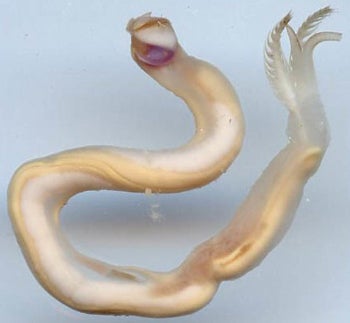
La página que intenta visitar sólo está disponible en inglés. ¡Disculpa!
The page you are about to visit is currently only available in English. Sorry!

In 1731 a Dutch commission described the shipworms that literally ate the dikes of Holland as a “horrible plague.” Almost two-hundred years later shipworms chewed their way through the piers and wharves of San Francisco. But these despised, wood-eating, wormlike mollusks are now being touted in the search for more practical biofuels.
Once proclaimed as the solution to clean energy, biofuels like soybeans and corn are currently being scrutinized for their contribution to rising food prices and hunger in poor countries. A United Nations Food and Agriculture Organization report released Tuesday calls for biofuel subsidies to be “urgently reviewed in order to preserve the goal of world food security.” The recent flack against corn makes the search for shipworms all the more prescient and projects like that of the Philippine Mollusk Symbiont International Cooperative Biodiversity Group (PMS-ICBG), all the more purposeful.
Last week this group of Philippine and American scientists were awarded a $4 million grant from the National Institutes of Health, with support from the U.S. Department of Energy and the National Science Foundation, to survey mollusks in the Philippine archipelago for chemicals that could yield nervous system disorder and cancer drugs and enzymes capable of breaking down cellulose into ethanol, considered by some energy experts as the holy grail in the quest for viable biofuels. An estimated 10,000 marine mollusks inhabit the Philippines, including the giant clam and blue-ring octopuses, but it’s the shipworms, which rely on bacteria to metabolize wood fibers, that pose the most exciting prospects for alternative energy.
“I think we’re the first people who have done much research on them with any other intent than to try and kill them,” said Dan Distel, a shipworm expert with the PMS-ICBG.

Bankia setacea, one type of shipworm. Some species are as long as six feet. (Courtesy of Dr. D.L. Distel, Ocean Genome Legacy),
Distel directs the Ocean Genome Legacy, a Massachusetts-based research foundation dedicated to preserving the genetic biodiversity of life in the oceans. He has studied shipworms for two decades and for just as long few people have cared. Then oil prices went through the roof. “Suddenly with the energy crisis my phone is starting to ring,” said Distel.
One call came from Margo Haygood, a microbiologist at Oregon Health & Science University, and lead investigator of the PMS-ICBG study. The two exchanged ideas in the past when they both were studying bacterial enzymes in search of anti-cancer drugs. Haygood is now collaborating with Distel on a paper sequencing the genome of shipworm bacteria, which sustain the mollusks woody diet by metabolizing cellulose for them. The hope is that some aspect of that genome for some strain of bacteria in some type of shipworm will yield enzymes that will help convert wood to the sugars necessary for making ethanol in a more efficient manner than is already possible. The Philippines are an ideal location because the archipelago’s incredible biodiversity enhances the chances of finding shipworms with suitable enzymes. “We hope that some strains will produce the enzymes we’re looking for,” said Haygood.
And with markets tumbling, oil becoming more and more political and both presidential candidates growing fond of terms like “safe nuclear” and “clean coal” the whole nation will be looking on too.
“Spending million of dollars looking for marine clams sounds like one of those things politicians would use as examples of pork,” said Distel. “The fact is that’s where we find those unexpected things and we’re just scratching the surface; bioenergy in the oceans have enormous potential.”